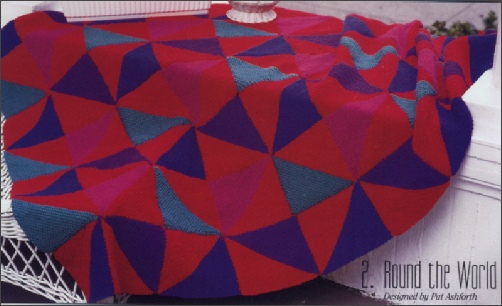




It all began in 1996 with this design which was named Around the World.
We had already spent several years designing and knitting sweaters and other garments using mathematical principles instead of conventional patterns. In 1994 we had written Woolly Thoughts and we had been on the internet, and members of various fibrecraft groups there, since that year.
One of the advantages, or disadvantages, of the internet is that you don’t really know who you are talking to. You might feel you know someone very well but you can only base your opinions on what they choose to tell about themselves, and on your own intuition. We were taken by surprise when one of the people we had been chatting with for months revealed that she worked for Brown Sheep, a large American yarn company. She asked us to design an afghan for her company. We agreed and promptly went into a state of panic as we had not the vaguest idea what an afghan was.
We soon discovered that it was a blanket or throw, and watching American television soaps it soon became obvious that they were extremely common in America but, as yet, unheard of in Britain. We didn’t know anything about the size, style or anything else. All the American friends we had made were the obvious source of information so we sent out emails to everyone we could think of asking how big an afghan should be; whether it should be square; would an irregular shape be acceptable; many other questions. Every reply was different. There was very little consensus of opinion though most agreed that although many designs were rectangular they would rather like some more interesting shapes.
We set to work and produced four designs for the company to choose from. They ranged
from a very simple design to a complex-
Normally, a knitter is asked to make up their own design to be photographed for the pattern. In this case, due to the time factor and difficulties associated with sending the materials backwards and forwards across the Atlantic, they arranged for someone to knit it in America. There was a point where we thought it wouldn’t happen. Our way of working is that a diagonal square has to be made to a particular size, not to a number of stitches. It can be made in any yarn and will still be the correct size. This didn’t fit with the traditional knitting pattern where the instructions are very precise and tell the knitter how many stitches they should have at any time. Obviously, they wanted to sell their yarn rather than have people buy the pattern then go elsewhere for the yarn. We had always said any yarn could be used. These two approaches seemed to be poles apart. Brown Sheep came up with a very nice compromise. They wrote a separate set of instructions for every yarn in their range. The same size square would be achieved whichever of their yarns was used and they gave the number of stitches on the diagonal for each type of yarn. They called their pattern Around the World.
This was a major breakthrough in our designing careers. With the discovery of afghans
came the realisation that we could use mathematical methods to represent mathematical
ideas on a large scale. Our main function was still as Mathematics teachers. The
afghan proved to be a wonderful Blanket Canvas for teaching Maths -
I doubt if the people at Brown Sheep are aware of what they started.
